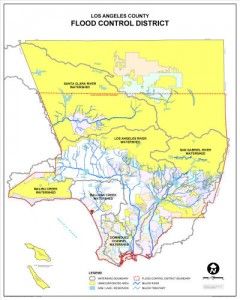Federal courts throw out excessive storm water regulations
by CalWatchdog Staff | January 9, 2013 9:13 am
 [1]Jan. 9, 2013
[1]Jan. 9, 2013
By Wayne Lusvardi
The expression “don’t throw the baby out with the bathwater” means avoiding throwing something out that is good when trying to get rid of something bad. In two separate recent California court cases dealing with attempts to expand the definition of storm water as polluted water, federal courts have thrown out the bad definitions and kept the essential.
The first case[2], Virginia Department of Transportation vs. EPA, came down on Jan. 3. The Virginia Federal District Court ruled that the federal EPA could not force the Virginia Department of Transportation to use sediment as a substitute or “proxy” measure of water pollution. The federal Clean Water Act regulates pollutants, not water flows. As a summary by the Pacific Legal Foundation put it, “Rivers are rivers.”
The second case[3] was Los Angeles County Flood Control District vs. the National Resources Defense Council and was decided on Jan. 8 by the U.S. Supreme Court. It ruled that the NRDC could not force the district to regulate the flow of polluted water from a concrete-lined river into a natural watercourse as a “discharge of pollutants.” As Tony Francois[4] of the Pacific Legal Foundation summed up the case, “A river does not discharge (water) to itself.” The L.A. County case involved confirmed pollution by monitoring stations in river channels, but where there is currently no way to determine who polluted it.
This is what the law conventionally calls “nexus” — a legally determined connection between the source and the resulting pollution. Without nexus there is no pollution discharge because it is presently impossible to determine the source of the pollution or who is liable for it. In other words, you can’t make an innocent industry or homeowner that may not have polluted the water responsible for cleaning up the pollution.
Proposed L.A. County rain water clean up program
The Los Angeles County case has been watched carefully because in 2010 the California Legislature passed Assembly Bill 2554[5] that forces the county to clean up all rainwater as pollution. To comply with AB 2554, the county is asking voters to approve mega-millions of dollars in additional taxes for its “Clean Water–Clean Beaches”[6] program.
But the county is already spending hundreds of millions of dollars in storm water cleanup. The County’s storm water cleanup program would install catchment basins for about every 100 acres of urban land area, or every 350 homes. This would total 18,086 new storm water catchment basins to trap rainwater from seven watersheds that flow into the Los Angeles River, San Gabriel River, Dominguez Channel and the Santa Clara River.
The U.S. Supreme Court has limited the Obama Administration’s EPA and the NRDC from trying to expand the definition of what is polluted water and what is a discharge of polluted rain water. The Los Angeles County case has been returned to the lower courts for now.
The proverbial baby has not been thrown out with the dirty bathwater yet.
But don’t expect the push to expand the definition of rainwater as pollution to go away. Babies can’t vote. But Los Angeles property owners will have an opportunity to vote on the County’s “Clean Water–Clean Beaches” program through a mail-in ballot in 2013.
- [Image]: http://www.calwatchdog.com/2013/01/09/federal-courts-throw-out-excessive-storm-water-regulations/los-angeles-flood-control-district-map/
- first case: http://blog.pacificlegal.org/2013/rivers-are-rivers/#more-11617
- second case: http://www.aquafornia.com/wp-content/uploads/2013/01/SCOTUS-stormwater-decision.pdf
- Tony Francois: http://blog.pacificlegal.org/2013/rivers-are-rivers/#more-11617
- Assembly Bill 2554: http://www.leginfo.ca.gov/pub/09-10/bill/asm/ab_2551-2600/ab_2554_bill_20100930_chaptered.html
- “Clean Water–Clean Beaches”: http://www.lacountycleanwater.org/
Source URL: https://calwatchdog.com/2013/01/09/federal-courts-throw-out-excessive-storm-water-regulations/